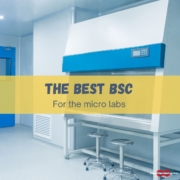How to choose the best culture media for Environmental Monitoring in pharmaceutical microbiology?
Choosing a supplier for culture media for environmental monitoring in the pharmaceutical industry is not a step to be taken lightly.
A poor choice can be very detrimental not only to the lab but also to production.
To help you make the right decision, we have listed in this article the key points to check before selecting a new culture media supplier.
Content:
- What are the culture media used for environmental monitoring?
- How to choose an effective culture media?
- Key criteria for Petri dishes
- Logistics of culture media
- Assess the competencies of a culture media supplier
Best Culture Media
Discover the 4 BEST Culture Media Suppliers
We survey the SuperMicrobiologists.
Here are their favorite EM culture media.
What are the culture media used for environmental monitoring?
Environmental monitoring in the pharmaceutical industry uses specific culture media. For surface monitoring, there are contact plates (also called RODAC or 55mm plates), and for active or passive air monitoring, settle plates (also called sedimentation plate or 90mm plates) are used.
The basic compositions for agar plates are TSA (Tryptic Soy Agar) and SDA (Sabouraud Dextrose Agar). For environmental monitoring, these media are often supplemented with neutralizers. Their role is to neutralize any disinfectant residues that could inhibit microbial growth (e.g., LTHT, β-lactamases, or others).
If the media is intended for use in an isolator or critical sterile area (sterile pharmaceutical industry), it is triple-packed and irradiated. For less critical environments (non-sterile pharmaceutical industry), the media are available with simple packaging.
1 – How to choose an effective culture media?
Here we will talk about what’s inside our Petri dishes, the agar culture media.
The technical performances of the culture media
No, not all TSA plates are the same… Even if you follow the same recipe as a top chef, your dish might not taste the same! It’s the same with culture media. Even though the composition is the same, each supplier has its own “secret recipe.”
Additionally, the choice of raw materials can greatly affect the performance of the agar.
Ask your supplier how they verify the performance of their culture media. Do they test strains beyond those in the pharmacopeia? What are their performance criteria for raw materials?
Some suppliers test the microbiological performance of their raw materials with dozens of strains. If the strains don’t grow well, they reject the batch of raw materials.
Our tips : Test several batches with pharmacopeial strains as well as your environmental strains. Question or audit the supplier about their internal tests.
The effectiveness of neutralizers
This point is extremely important but often overlooked by microbiology labs.
Disinfectant formulations have evolved a lot in recent years. It’s essential to ensure that the culture media can properly neutralize any residues that may be present in the air or on surfaces. If neutralization doesn’t work, it can prevent contamination from growing, leading to a false negative result. And for microbiologists, false negatives are a real headache!
You should check how well the neutralizers work based on the disinfectants used in your sampling areas.
Humidity issues in Petri dishes
This humidity comes from water molecules (no surprise there) released by the agar.
This happens:
- During production: The Petri dish lid is closed while the agar is still warm (releasing steam).
- During storage : Due to temperature changes, which causes the agar to release water that it doesn’t reabsorb.
This humidity can affect:
- The fertility of the culture media.
- The sterility: Water droplets can create a bridge between the inside and outside of the dish, allowing contamination to pass from the outside air into the agar (e.g., contamination from the incubator air to the dish).
Some suppliers add a desiccant to the Petri plate packaging to reduce this problem.
Drying issues with agar
During sedimentation monitoring, agar plates can lose a lot of water, especially if these controls are performed under airflows. In such conditions, the agar can dry out and crack, which makes the results unusable (leading to a deviation).
It’s important to choose agar with as much filling volume as possible.
Our tips : Test the “worst-case scenario”
– X hours of exposure under your most powerful flux. (X = your longest exposure)
– Y hours of incubation. (Y = your longest incubation)
Then check if the agar has cracked. You can even weigh the agar before and after to measure how much water has been lost.
To go further, you can perform a fertility check by inoculating just before incubation.
The Certificate of Analysis (CoA)
Check that the Certificate of Analysis includes all the tests you need. This is usually the case, but you can still get surprises, even with well-known suppliers.
2 – Key criteria for choosing a good Petri dishes
Here we will talk about the small plastic container that is the Petri dish.
The strenght of the Petri dish
Not all plastics are the same.
They can have different consistencies, thicknesses, and forms. Petri dishes go through a lot during sampling and incubation. To avoid breaking too many, it’s best to choose solid ones.
Our tips : Handle the dishes and have your sampling team handle them as well.
The Petri lid closure
To move from the sampling area to the incubation area, it’s better to use dishes that close securely. Ideally, the closure should be easy and intuitive to avoid mistakes.
Some dishes offer a position for anaerobic incubation—check if this feature is useful for your lab.
Our tips : Handle the dishes and have your sampling team handle them as well.
Labeling of the Petri dish
For traceability, Petri dishes are labeled by the supplier. To avoid interfering with reading, a label on the edge is a plus. Make sure the information on the label suits your needs (barcode, name, expiration date, batch, unique dish number, etc.) and is easy to read.
Note that there are different barcode formats. The GS1 format allows scanners to instantly decode the information (the scanner extracts the details and sorts them into the right columns). For other codes, the scanner needs to be “told” what each piece of information means (like expiration date) and where to store it.
Triple bagged and irradiation
Depending on the criticality of the area where you use the agar plates, the plates can be single or triple packaged and irradiated.
Irradiation doesn’t “sterilize” the agar, but it sterilizes the packaging. This process can affect the fertility of the agar. To maintain certain properties, irradiated agar plates are usually supplemented (this is one of the supplier’s trade secrets).
An irradiated agar does not necessarily equal a non-irradiated agar.
Our tips : Check that the packaging is impermeable to the sterilization treatments you’ll perform in your production isolators. Also, test how easy it is to handle the packaging (for opening with isolator gloves).
Bonus: Compatibility with smart incubators and colony counters
In the coming years, we’ll likely see more smart incubators. These devices incubate and regularly read the agar plates. So, it’s essential that your dishes are compatible with this use.
You’ll need to ensure the dish format is physically compatible, but also that it can be read across the entire surface. There may be writings or arrows engraved in the plastic, which could interfere with reading.
3 – Logistics of culture media
Storage temperature of agar plates
At what temperatures should agar plates be stored? Cold or room temperature… and what does “room temperature” really mean?
Ideally, the microbiology lab should be able to store as many plates as possible. This reduces delivery costs and prevents the need for multiple tests upon receipt. It’s also important to know where you have the most storage space.
Another advantage of room-temperature (or controlled-temperature) storage: If the agar is contaminated, it’s immediately visible—something that’s not always true with cold storage!
In any case, you should avoid temperature fluctuations and try to maintain a constant temperature from the supplier’s production site to your lab. Temperature variations can cause humidity issues in the Petri dishes.
Single-lot deliveries of culture media
To minimize the number of growth promotion test and sterility tests upon receipt, ask the supplier for single-lot deliveries.
Our tips : Ask your supplier if they can commit to single-lot deliveries.
Shelf life of the culture media
While it’s good to know the expiration date from the production date, what’s more important is the minimum shelf life upon receipt.
The expiration should cover your needs until the next delivery. A longer shelf life allows for fewer deliveries (as long as you have storage space) and reduces the number of tests upon receipt.
Delivery of culture media
Are the deliveries made in temperature-controlled trucks?
In winter, outside temperatures can be below freezing, and in summer, truck temperatures can easily reach 50°C! It’s essential to control the temperature during transport and to be able to monitor it. Some suppliers offer temperature trackers with each delivery.
The simplest approach is to create a delivery schedule with your supplier for the entire year. But in case of an issue, how quickly can the supplier provide a replacement? That could save critical situations.
Our tips : Set up a schedule with your supplier to plan deliveries over the course of one year.
4 – Assess the competencies of a culture media supplier
This applies to all consumables, but especially to culture media. If something goes wrong, the entire production can be disrupted.
The bad news is that you will face issues with culture media, even if you pick the “best” supplier.
What matters most is how your supplier handles these issues (fertility, drying out, broken dishes, etc.). When problems occur, you need a quick response from your supplier.
It’s always a good idea to have a main supplier and a backup supplier for culture media… just in case! Ideally, you can order from both, for example, with an 80-20% split.
Our tips:
– Audit the supplier and get to know their technically skilled contacts.
– Check their accessibility. Do you have a direct email address or phone number?
– Most importantly, ask 2 or 3 other labs about their experience with the supplier… or read our dedicated article about the SuperMicrobiologistes favorite culture media.
You now have all the tools to choose the best culture media supplier for our lab, it’s up to you!
Let us know in comment which one you choose.













Trackbacks & Pingbacks
[…] These results show that choosing a culture media supplier is not a decision to take lightly. If you want to go further, we recommend reading this article, which explains how to select the right agar for your environmental controls. […]
[…] The first step is to create a requirements specification, and you can find all our tips in this article “How to choose the best culture media for Environmental Monitoring in pharmaceutical microbiology?… […]
Leave a Reply
Want to join the discussion?Feel free to contribute!